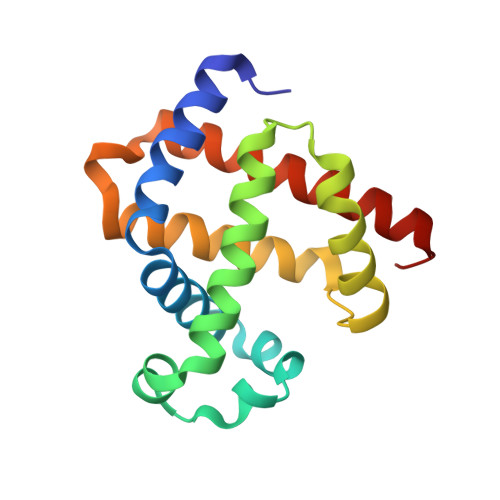Amphitrite ornata Dehaloperoxidase (DHP): Investigations of Structural Factors That Influence the Mechanism of Halophenol Dehalogenation Using "Peroxidase-like" Myoglobin Mutants and "Myoglobin-like" DHP Mutants.
Du, J., Huang, X., Sun, S., Wang, C., Lebioda, L., Dawson, J.H.(2011) Biochemistry 50: 8172-8180
- PubMed: 21800850
- DOI: https://doi.org/10.1021/bi2009129
- Primary Citation of Related Structures:
3SDN - PubMed Abstract:
Dehaloperoxidase (DHP), discovered in the marine terebellid polychaete Amphitrite ornata, is the first heme-containing globin with a peroxidase activity. The sequence and crystal structure of DHP argue that it evolved from an ancient O(2) transport and storage globin. Thus, DHP retains an oxygen carrier function but also has the ability to degrade halophenol toxicants in its living environment. Sperm whale myoglobin (Mb) in the ferric state has a peroxidase activity ∼10 times lower than that of DHP. The catalytic activity enhancement observed in DHP appears to have been generated mainly by subtle changes in the positions of the proximal and distal histidine residues that appeared during DHP evolution. Herein, we report investigations into the mechanism of action of DHP derived from examination of "peroxidase-like" Mb mutants and "Mb-like" DHP mutants. The dehalogenation ability of wild-type Mb is augmented in the peroxidase-like Mb mutants (F43H/H64L, G65T, and G65I Mb) but attenuated in the Mb-like T56G DHP variant. X-ray crystallographic data show that the distal His residues in G65T Mb and G65I are positioned ∼0.3 and ∼0.8 Å, respectively, farther from the heme iron compared to that in the wild-type protein. The H93K/T95H double mutant Mb with the proximal His shifted to the "DHP-like" position has an increased peroxidase activity. In addition, a better dehaloperoxidase (M86E DHP) was generated by introducing a negative charge near His89 to enhance the imidazolate character of the proximal His. Finally, only minimal differences in dehalogenation activities are seen among the exogenous ligand-free DHP, the acetate-bound DHP, and the distal site blocker L100F DHP mutant. Thus, we conclude that binding of halophenols in the internal binding site (i.e., distal cavity) is not essential for catalysis. This work provides a foundation for a new structure-function paradigm for peroxidases and for the molecular evolution of the dual-function enzyme DHP.
Organizational Affiliation:
Department of Chemistry and Biochemistry, University of South Carolina, Columbia, South Carolina 20208, USA.

















